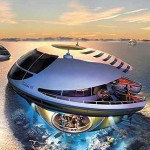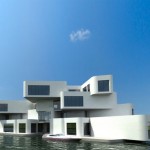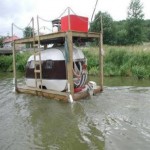[ By WebUrbanist in Architecture & Public & Institutional. ]

Located in the north of Amsterdam, the recently-opened De Ceuval (conceptualized by Space&Matter) is a radical redevelopment project featuring homes, offices, restaurants and gardens, all accessed via elevated winding platforms that connect renovated houseboats.


A former shipping wharf, this brownfield site is being transformed from a polluted wasteland into a temporary ten-year creative haven, all designed to revitalize and rehabilitate the land it occupies and leave it cleaner at the end of its lease.


The complex is made up of an array of formerly-floating homes that are no longer seaworthy but can still be fixed up and find a second life on land. As PopUpCity reports, “The imaginatively retro-fitted houseboats that make up the creative quarter are all placed around a winding bamboo walkway and the surrounding landscape consists of plants that clean the soil.”


An incredible array of sustainable strategies are being employed in the development, both for the benefit of the site and to educate the public, showing off “new technologies that can transform how we produce and consume resources and public services in cities. Throughout the site, solar technologies will convert energy from the sun into heat and electricity. Green roofs and water collection systems are designed to collect, purify, and store rainwater for when it’s needed. Sanitation systems will extract energy, nutrients, and water from the waste produced for on-site food production. A network of sensors provide information on performance and user behavior.”


One of the central features of the program is the Ceuvel Café, designed as a gathering and eating space for tenants and visitors alike, featuring “lectures, workshops and tastings. In the future, it will also be possible to buy locally produced vegetables [and attend] guided tours and events. Ceuvel Café will also act as a stage for artists, musicians, theat[rical performers] and filmmakers.”


The entire complex is meant to serve not only the designer and architects who occupy it, but the environment around it, using green tactics of all kinds including “high-tech systems like sensors, monitoring devices, solar panels, and high-efficiency electric boilers. Low-tech systems also play an important role, including biological waste processing, water filtration, smart insulation methods, vegetation, and solar tubes that provide more natural light to indoor spaces.”




[ By WebUrbanist in Architecture & Public & Institutional. ]
[ WebUrbanist | Archives | Galleries | Privacy | TOS ]



You must be logged in to post a comment.